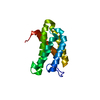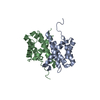+ Open data
Open data
- Basic information
Basic information
| Entry | Database: PDB / ID: 7oom | ||||||
|---|---|---|---|---|---|---|---|
| Title | N-terminal domain of FlSp spidroin from Nephila clavipes | ||||||
 Components Components | Flagelliform spidroin variant 1 | ||||||
 Keywords Keywords | STRUCTURAL PROTEIN / Spider silk / spidroin | ||||||
| Function / homology | Spidroin, N-terminal / Major ampullate spidroin 1, spider silk protein 1, N-term / Spidroin, N-terminal domain superfamily / Flagelliform spidroin variant 1 Function and homology information Function and homology information | ||||||
| Biological species |  Nephila clavipes (spider) Nephila clavipes (spider) | ||||||
| Method |  X-RAY DIFFRACTION / X-RAY DIFFRACTION /  SYNCHROTRON / SYNCHROTRON /  SAD / Resolution: 1.8 Å SAD / Resolution: 1.8 Å | ||||||
 Authors Authors | Tars, K. / Metlans, R. / Fridmanis, J. / Jaudzems, K. | ||||||
| Funding support |  Latvia, 1items Latvia, 1items
| ||||||
 Citation Citation |  Journal: J.Biol.Chem. / Year: 2022 Journal: J.Biol.Chem. / Year: 2022Title: The dimerization mechanism of the N-terminal domain of spider silk proteins is conserved despite extensive sequence divergence. Authors: Sarr, M. / Kitoka, K. / Walsh-White, K.A. / Kaldmae, M. / Metlans, R. / Tars, K. / Mantese, A. / Shah, D. / Landreh, M. / Rising, A. / Johansson, J. / Jaudzems, K. / Kronqvist, N. | ||||||
| History |
|
- Structure visualization
Structure visualization
| Structure viewer | Molecule:  Molmil Molmil Jmol/JSmol Jmol/JSmol |
|---|
- Downloads & links
Downloads & links
- Download
Download
| PDBx/mmCIF format |  7oom.cif.gz 7oom.cif.gz | 61.4 KB | Display |  PDBx/mmCIF format PDBx/mmCIF format |
|---|---|---|---|---|
| PDB format |  pdb7oom.ent.gz pdb7oom.ent.gz | 44.9 KB | Display |  PDB format PDB format |
| PDBx/mmJSON format |  7oom.json.gz 7oom.json.gz | Tree view |  PDBx/mmJSON format PDBx/mmJSON format | |
| Others |  Other downloads Other downloads |
-Validation report
| Arichive directory |  https://data.pdbj.org/pub/pdb/validation_reports/oo/7oom https://data.pdbj.org/pub/pdb/validation_reports/oo/7oom ftp://data.pdbj.org/pub/pdb/validation_reports/oo/7oom ftp://data.pdbj.org/pub/pdb/validation_reports/oo/7oom | HTTPS FTP |
|---|
-Related structure data
| Related structure data |  7a0iC  7a0oC C: citing same article ( |
|---|---|
| Similar structure data | Similarity search - Function & homology  F&H Search F&H Search |
- Links
Links
- Assembly
Assembly
| Deposited unit | 
| ||||||||
|---|---|---|---|---|---|---|---|---|---|
| 1 |
| ||||||||
| Unit cell |
|
- Components
Components
| #1: Protein | Mass: 14256.615 Da / Num. of mol.: 2 Source method: isolated from a genetically manipulated source Source: (gene. exp.)  Nephila clavipes (spider) / Gene: Flag / Production host: Nephila clavipes (spider) / Gene: Flag / Production host:  #2: Water | ChemComp-HOH / | |
|---|
-Experimental details
-Experiment
| Experiment | Method:  X-RAY DIFFRACTION / Number of used crystals: 1 X-RAY DIFFRACTION / Number of used crystals: 1 |
|---|
- Sample preparation
Sample preparation
| Crystal | Density Matthews: 1.92 Å3/Da / Density % sol: 35.92 % |
|---|---|
| Crystal grow | Temperature: 293 K / Method: vapor diffusion, sitting drop / pH: 5.5 Details: The crystals were obtained by siting drop vapor technique by mixing 1 ul of protein (10 mg/ml in 20 mM Na acetate, 10 mM NaCl, pH 5.5) with 1ul of 0.2M MgCl2, 0.1M bis-tris pH 5.5, 25% PEG 3350 |
-Data collection
| Diffraction | Mean temperature: 100 K / Serial crystal experiment: N | |||||||||||||||||||||||||||||||||||||||||||||||||||||||||||||||||||||||||||||||||||||||||||||||||||||||||||||||||||||||||
|---|---|---|---|---|---|---|---|---|---|---|---|---|---|---|---|---|---|---|---|---|---|---|---|---|---|---|---|---|---|---|---|---|---|---|---|---|---|---|---|---|---|---|---|---|---|---|---|---|---|---|---|---|---|---|---|---|---|---|---|---|---|---|---|---|---|---|---|---|---|---|---|---|---|---|---|---|---|---|---|---|---|---|---|---|---|---|---|---|---|---|---|---|---|---|---|---|---|---|---|---|---|---|---|---|---|---|---|---|---|---|---|---|---|---|---|---|---|---|---|---|---|---|
| Diffraction source | Source:  SYNCHROTRON / Site: SYNCHROTRON / Site:  MAX IV MAX IV  / Beamline: BioMAX / Wavelength: 0.9788 Å / Beamline: BioMAX / Wavelength: 0.9788 Å | |||||||||||||||||||||||||||||||||||||||||||||||||||||||||||||||||||||||||||||||||||||||||||||||||||||||||||||||||||||||||
| Detector | Type: DECTRIS EIGER X 16M / Detector: PIXEL / Date: Mar 19, 2021 | |||||||||||||||||||||||||||||||||||||||||||||||||||||||||||||||||||||||||||||||||||||||||||||||||||||||||||||||||||||||||
| Radiation | Protocol: SINGLE WAVELENGTH / Monochromatic (M) / Laue (L): M / Scattering type: x-ray | |||||||||||||||||||||||||||||||||||||||||||||||||||||||||||||||||||||||||||||||||||||||||||||||||||||||||||||||||||||||||
| Radiation wavelength | Wavelength: 0.9788 Å / Relative weight: 1 | |||||||||||||||||||||||||||||||||||||||||||||||||||||||||||||||||||||||||||||||||||||||||||||||||||||||||||||||||||||||||
| Reflection | Resolution: 1.8→44.39 Å / Num. obs: 18569 / % possible obs: 92.6 % / Redundancy: 5.4 % / Rpim(I) all: 0.042 / Rrim(I) all: 0.103 / Rsym value: 0.094 / Net I/av σ(I): 4 / Net I/σ(I): 10.7 | |||||||||||||||||||||||||||||||||||||||||||||||||||||||||||||||||||||||||||||||||||||||||||||||||||||||||||||||||||||||||
| Reflection shell | Diffraction-ID: 1
|
- Processing
Processing
| Software |
| ||||||||||||||||||||||||||||||||||||||||||||||||||||||||||||
|---|---|---|---|---|---|---|---|---|---|---|---|---|---|---|---|---|---|---|---|---|---|---|---|---|---|---|---|---|---|---|---|---|---|---|---|---|---|---|---|---|---|---|---|---|---|---|---|---|---|---|---|---|---|---|---|---|---|---|---|---|---|
| Refinement | Method to determine structure:  SAD / Resolution: 1.8→44.39 Å / Cor.coef. Fo:Fc: 0.956 / Cor.coef. Fo:Fc free: 0.947 / SU B: 3.068 / SU ML: 0.095 / Cross valid method: THROUGHOUT / σ(F): 0 / ESU R: 0.16 / ESU R Free: 0.138 / Stereochemistry target values: MAXIMUM LIKELIHOOD SAD / Resolution: 1.8→44.39 Å / Cor.coef. Fo:Fc: 0.956 / Cor.coef. Fo:Fc free: 0.947 / SU B: 3.068 / SU ML: 0.095 / Cross valid method: THROUGHOUT / σ(F): 0 / ESU R: 0.16 / ESU R Free: 0.138 / Stereochemistry target values: MAXIMUM LIKELIHOODDetails: HYDROGENS HAVE BEEN ADDED IN THE RIDING POSITIONS U VALUES : REFINED INDIVIDUALLY
| ||||||||||||||||||||||||||||||||||||||||||||||||||||||||||||
| Solvent computation | Ion probe radii: 0.8 Å / Shrinkage radii: 0.8 Å / VDW probe radii: 1.2 Å / Solvent model: MASK | ||||||||||||||||||||||||||||||||||||||||||||||||||||||||||||
| Displacement parameters | Biso max: 85.31 Å2 / Biso mean: 26.359 Å2 / Biso min: 10.15 Å2
| ||||||||||||||||||||||||||||||||||||||||||||||||||||||||||||
| Refinement step | Cycle: final / Resolution: 1.8→44.39 Å
| ||||||||||||||||||||||||||||||||||||||||||||||||||||||||||||
| Refine LS restraints |
| ||||||||||||||||||||||||||||||||||||||||||||||||||||||||||||
| LS refinement shell | Resolution: 1.8→1.847 Å / Rfactor Rfree error: 0 / Total num. of bins used: 20
|
 Movie
Movie Controller
Controller



 PDBj
PDBj
